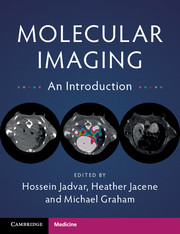Book contents
- Frontmatter
- Contents
- List of Contributors
- Preface
- 1 Instrumentation – CT
- 2 MRI/ MRS Instrumentation and Physics
- 3 Optical and Ultrasound Imaging
- 4 Instrumentation-Nuclear Medicine and PET
- 5 Quantitation-Nuclear Medicine
- 6 Perfusion
- 7 Metabolism
- 8 Cellular Proliferation
- 9 Hypoxia
- 10 Receptor Imaging
- 11 Apoptosis
- 12 Angiogenesis
- 13 Reporter Genes
- 14 Stem Cell Tracking
- 15 Amyloid Imaging
- Index
2 - MRI/ MRS Instrumentation and Physics
Published online by Cambridge University Press: 22 November 2017
- Frontmatter
- Contents
- List of Contributors
- Preface
- 1 Instrumentation – CT
- 2 MRI/ MRS Instrumentation and Physics
- 3 Optical and Ultrasound Imaging
- 4 Instrumentation-Nuclear Medicine and PET
- 5 Quantitation-Nuclear Medicine
- 6 Perfusion
- 7 Metabolism
- 8 Cellular Proliferation
- 9 Hypoxia
- 10 Receptor Imaging
- 11 Apoptosis
- 12 Angiogenesis
- 13 Reporter Genes
- 14 Stem Cell Tracking
- 15 Amyloid Imaging
- Index
Summary
Magnetic Resonance Fundamentals
Magnetic resonance imaging (MRI) involves acquiring signals generated by the protons of water and fat molecules in the body in a strong magnetic field. When an object is placed in an MR scanner, the protons, or spins, will align either parallel or anti-parallel to the field, with a small net number of protons aligning parallel to the field (longitudinal direction), creating a stable equilibrium net magnetization pointing along the main field. When a radiofrequency (RF) wave is applied to the spins, a process referred to as “excitation,” the protons absorb the RF energy such that the magnetization is effectively rotated into the transverse plane. This absorbed energy is subsequently released as magnetization returns to its initial state, similar to how a compass needle returns to its preferred equilibrium position (pointing north) when briefly perturbed by a nearby magnet. While the magnetization is in the transverse plane, it precesses about the direction of the main magnetic field, just as a spinning top precesses about the direction of the gravitational field. The frequency with which it precesses is called the Larmor frequency, which is dependent on the strength of the magnetic field and the gyromagnetic ratio, the latter of which for protons is 42.57 MHz/Tesla. The signal from the precessing magnetization can subsequently be detected using an RF receive coil for purposes of image creation or spectroscopy.
MR Hardware
A powerful external magnet is a major component of an MR scanner, most commonly with clinically utilized field strengths of 1.5 and 3.0 Tesla, which is placed in a room that is externally shielded by an RF shield to reduce or eliminate interference between radio waves from the outside environment and those obtained from the MRI examination. The high magnetic field strengths are produced by large currents that flow along superconducting wires wound about a cylindrical bore. The superconducting wires are kept cold with liquid helium compartment at ~4° K, which in turn is contained within a second compartment of liquid nitrogen (boiling point ~77° K). In addition, these liquid cryogen compartments are separated from the outermost casing of the scanner by a vacuum layer to minimize heat penetration. As the cryogens slowly boil off over time, they require periodic replenishment.
- Type
- Chapter
- Information
- Molecular ImagingAn Introduction, pp. 11 - 15Publisher: Cambridge University PressPrint publication year: 2017



